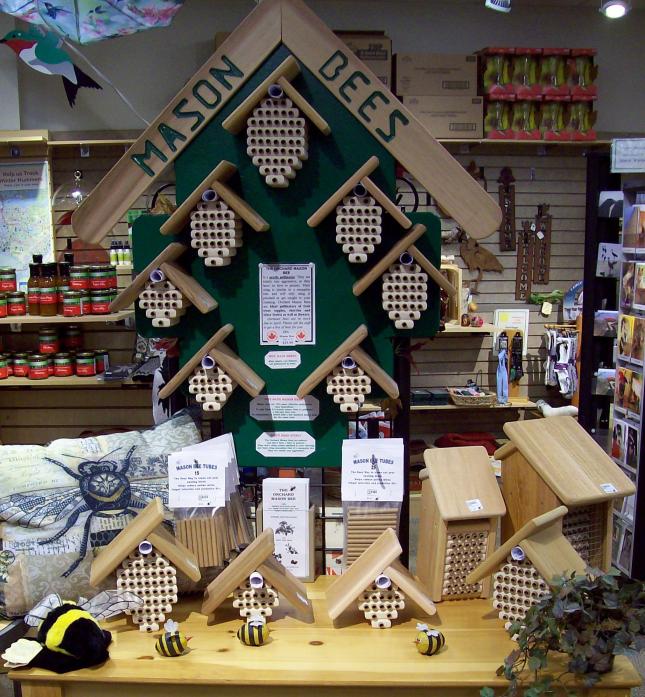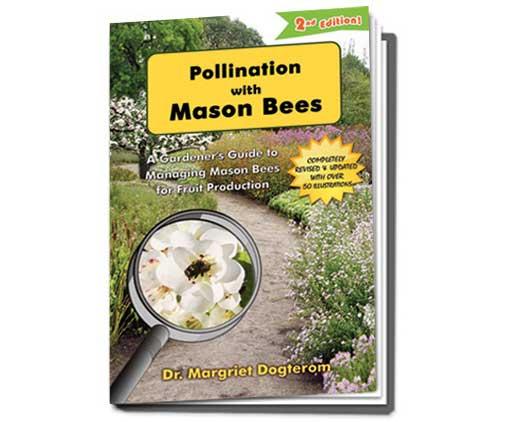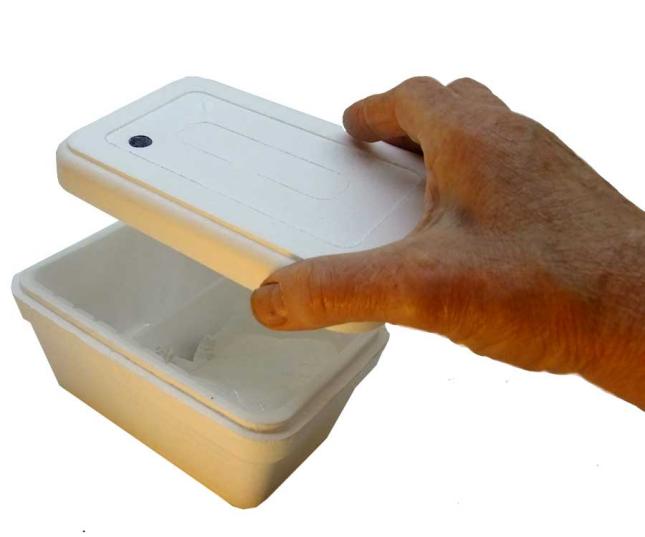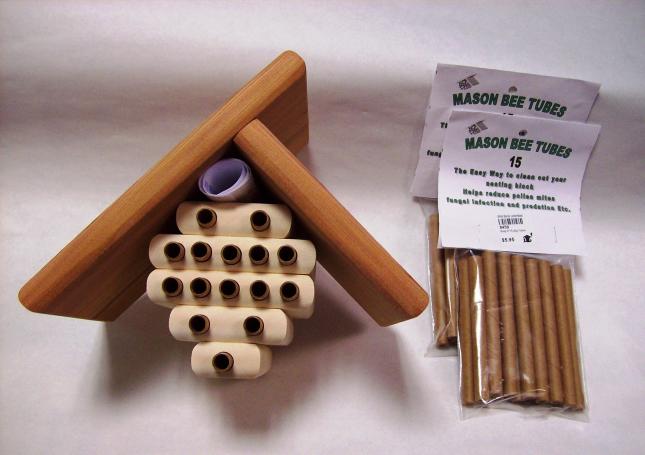Mason Bees
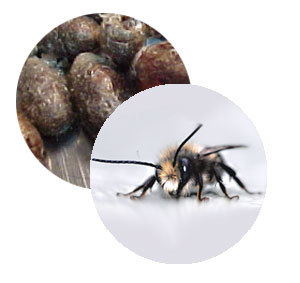
Mason bees have the ability to fly in our weather conditions and at lower temperatures than other bees. They are relatively easy to stage and care for. Native throughout southern Canada and continental USA, Blue Orchard Mason Bees are super-efficient, hard-working , spring crop pollinators: They collect nectar and pollen at the same time by lighting on the flower, taking nectar by tongue and collecting pollen using their rear and middle legs. A single female mason bee will visit nearly 2,000 blossoms a day and a smaller home orchard can be adequately pollinated by 40 – 50 bees. Ten mason bees will pollinate thousands of blossoms making them important for home garden pollination.
The mason bee is smaller than the honeybee, with a metallic blue body and two sets of wings. The smaller males have longer antennae than the females, and have hairs on the underside for carrying pollen.
Setting up nesting sites for these gentle, beneficial insects is fascinating, fun and good for our local environment. Creating a haven for mason bees at home is a wonderful educational opportunity for children of all ages. Kids can get up close and personal with the bees during their winter hibernation, when their nests are dismantled and their cocoons are cared for. Learning about their life cycles is a great first step in understanding garden ecology.
To increase fruit harvests, many people provide nest sites for mason bees. These small, solitary insects gather pollen over a short period of time in the spring to nourish their offspring in nesting holes. As they gather pollen, they pollinate fruit trees, cane fruit and strawberries. These bees are very easy to work with. They do not sting and go about their business even with you watching very closely. Mason bees provide a great educational opportunity for kids to learn about the life cycles of beneficial insects. Your goal should be to increase the native population in your yard by providing nest sites, caring for them over the winter and providing safe, clean nest sites the following year.
Mason Bee Requirements
Mason bees require three things to be successful in your garden:
- A nest to lay their eggs
- Food, in the form of nectar and pollen from flowers
- A source of mud
Storing and Releasing Mason Bees
If you want to store your bees over winter, or if you are purchasing cocoons before the mason bee season starts, you can store your cocoons in the fridge until you are ready to put them outside. Here are some tips on storing your bees in the fridge:
- Maintain fridge temperatures at 2-4°C and control for 60% or more humidity.
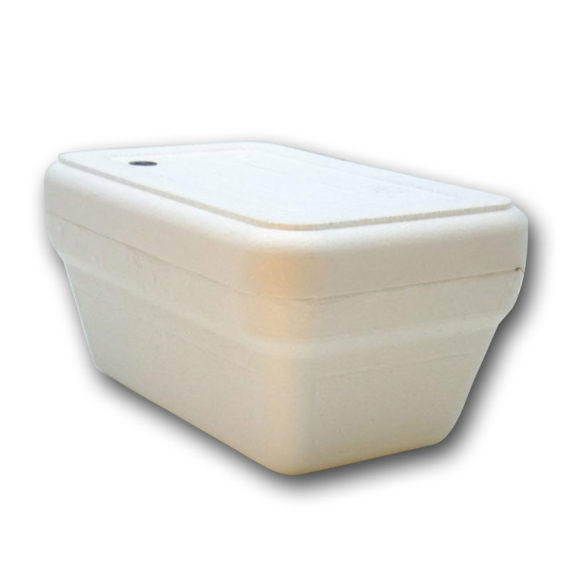
- Manual defrost fridges provide enough humidity for mason bee cocoons, whereas frost-free fridges do not.
- To provide enough humidity, store bees in a humidity cooler (pictured right) or place a damp paper towel in a container next to your cocoons.
- You can set out your mason bee cocoons when flowers in your yard are just about to bloom or are already in bloom. Having an available food source is critical for the bees throughout the length of their nesting season.
- Bees will start to emerge when temperatures reach approximately 13°C for three days in a row.
- Set cocoons out no later than mid May.
Cleaning your Mason Bee Cocoons
Open the Mason Bee blocks or tubes and gently remove all cocoons out of the Nesting channels. Remove as much mud as you can and place the cocoons in a strainer running lukewarm water over them to remove all mud off the cocoons.
Fill, a bowl with 2 quarts of cold water and 1 teaspoon of bleach. Place the cocoons in the bleach water and gently stir for approximately 2 to 3 minutes, which would take care of all mites that were left on them.
When this is done put your cocoons back in the strainer and rinse them with cold water. After rinsing, place them in a bowl with clean water and leave them there for approximately 3 to 4 minutes. Any cocoons that are not floating on the water, and sank to the bottom of the bowl, remove them and dispose of them. These may have insect predators inside of them or they are unhealthy cocoons.
Take your cocoons and put them back in the strainer and let the water drip off for a few minutes to get them as dry as possible. Put them on paper towel spreading them out evenly, then gently putting another paper towel on top to try to absorb as much water as you can off them.
The cocoons are now ready for storing in your fridge or leaving them outdoors in a cool location. If you store them in the fridge you need humidity of at least 60% . The temperature should be no higher than 38F. or 3.33C. If the temperature gets too warm they will start emerging and coming to life, therefore it is important to keep them cool until you are ready to release them in the spring.
They are now ready to start the new journey in the spring when you place them in their Mason Bee home.
Mason Bee Storage Quick Reference Guide [Click Here]
Why do Mason Bees need our help in nature for their survival?
1. Climate
In the winter months when the Mason Bees are normally dormant, several days of too-warm weather can trick their bodies into believing it's spring, and they can emerge early. Because there is no food for them in winter they will starve, and then if the temperature drops rapidly into a frost again the remaining can freeze to death,
2. Parasites & Predators
The Mason Bee brings in mites from the blossoms and takes them right into her nest, where they then multiply very quickly and destroy all the food the baby Mason Bees needs for survival. Mites will also walk to neighbouring nesting holes, infesting them too. They are very hearty parasites and will not die in cold weather, or even if you place them in your freezer.
Mason Bees tend to reuse the same locations from the year before where she laid her eggs, so if there are mites still living there when the next generation returns to continue the life cycle, they're unfortunately walking directly into a pre-existing infestation.
Mites may be harmful to native populations of mason bees, so cleaning the nest sites and cocoons is critical. It is important to remove the cocoons from the nest site and clean them to prepare for the next season. This is usually done in late October, when you gather the hibernating cocoons to wash them and store them over the winter. The Mason Bee book describes this well.
3. Houdini Fly
The Houdini Fly is one of our latest and most dangerous predators for Mason Bees. Originating from Europe, it will sit and wait outside the Mason Bee home and wait for the Mason Bees to leave. The Houdini Fly will then enter the home and lay her eggs on top of the Mason Bee larva. When the Houdini Fly eggs develop into maggots, they will immediately begin to eat the Mason Bee larva.
4. Parasitic Wasps
The Parasitic Wasp will lay it's eggs inside the bee larva. Dozen of adult wasps will emerge from each affected bee cocoon and then return to infect the larva the next pollination season. Harvest the Mason Bee cocoons each fall to reduce the attack of these sneaky pests. Around October (usually close to Halloween) when you see no more Mason Bees flying in and out of their nesting blocks, you can remove the nesting blocks to clean and prepare them for winter. This process keeps your Mason Bee cocoons safe over the winter from Mites, Houdini Flies, parasitic wasps, hungry birds and spiders, and more! It also gives you a jumpstart for the next pollination season, now that you've got a healthy and safe stock of bees.
Want to provide a safe place for these peaceful bees?
We carry a variety of Mason Bee homes that will suit your garden. Get all the information and supplies you need to get started and keep your bees healthy and productive.
We also (seasonally) have Mason Bee cocoons! Check in with us early-mid February for when you can pick up the start to your Mason Bee keeping journey.
